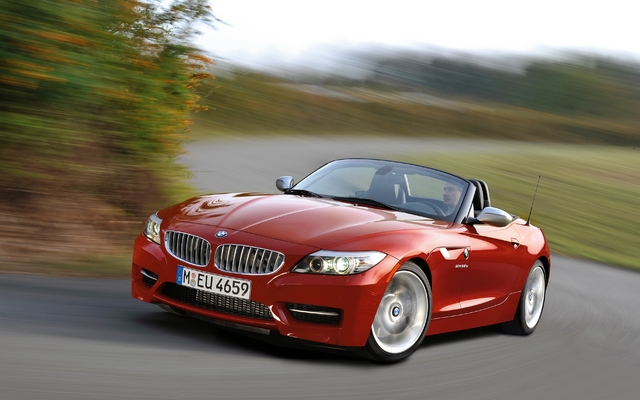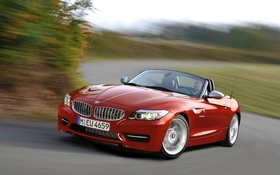2010 BMW Z4 sDrive35: An Homage to the Sports Car

| Strong points |
|
|---|---|
| Weak points |
|
Once in a while, a car comes along that causes you to question how you define a given class of vehicle. Family sedans, for example have gone from massive, V8-powered behemoths to diminutive Hybrid runabouts. Economy cars have gone from Messerschmitt bubble cars, to Reliant Robins, to Ford Falcons, to Smart cars. But one mainstay of the automotive community has remained relatively staid: the sports car.
For decades, what many would consider the purest of automotive designs have remained true to their roots. Nimble, quick, and constrained in proportion, there is a definite link that spans the decades between vehicle like the MGB and Mazda Miata. But in recent years, there’s been something a paradigm shift in sports car design. Leaning heavily on the technology that reinvented the workplace, automotive engineers have brought the full might of the electronic revolution to bear on the sports car market, and few vehicles demonstrate this as well as BMW’s all-new Z4.
Classically proportioned in a way few sports cars can match, there’s certainly no denying the strong sports car genealogy here. With curvaceous front fenders terminating in a short, abruptly vertical front end, it recalls the minimally aerodynamic sports cars of yore, albeit with a nod to the wind tunnel testing of today. Out back, wide, squat rear fenders imbue the car with the familiar coke-bottle shape that has given us such excellent designs as the early Corvettes and Carroll Shelby’s Cobra. The car carries significantly more visual weight over its rear axle than those old cars though; most likely the result of our blessedly higher crash safety requirements.
Because, cocooned back there between the rear fenders is where you, as a driver, will find yourself. Positioned just ahead of the rear wheelwell, the cabin’s placement is downright sublime, and compliments the car’s overall shape perfectly. It also creates a very potent illusion of size; making the whole car appear much larger than it is. However, measuring just 166 inches long and 50 inches tall, the new Z4 is still six inches shorter and five inches lower than the small-looking 1-series.
However, for all its design divinity, that seating position does give rise to what many would consider to be the one genetic fault inherent within sports car design since day one: trunk space. With the top up, there’s what I would call “just enough.” Although measuring two cubic feet larger than the outgoing model’s, the 2010 Z4’s eleven cubic feet is impinged upon by the contrivances that accompany nearly all folding hardtop designs. Around the perimeter, the large steel bars that support the tilting rear decklid reduces the overall diameter of the trunk, while the assortment of latches and contours that facilitate the operation of the manually-actuated partition make all but the softest of bags a struggle to fit. True to the sports car tradition and calling up the ubiquitous sports car cargo capacity measurement, BMW claims the trunk is capable of swallowing a pair of golf bags with the roof raised, with capacity limited to a single bag when lowered. However, while it’s possible to envision a pair of spartan, high-speed, low-drag golf bags (as I’m sure most German golf bags are) fitting within the trunk with the top up, the partition that must be in place for the roof’s operation reduces the trunk’s capacity to the degree that unless you’re hitting up your local pitch and putt, you may end up with your Callaways riding shotgun.
But cargo hauling is not exactly what a sports car is for, and for the purists out there, it’s not even on the list of criteria. For them, it’s what’s at the other end that counts. And there, beneath a hood that some critics would call phallic, is something that’s as impressive as the trunk is conservative. The latest in a long line of inline six motors, the Z4 sDrive35is uses the now-familiar 3.0L, twin-turbo powerplant to churn out 335 horsepower and 332 pound-feet of torque in a manner that’s absolutely, positively characteristic of BMW’s tremendous powerplants. This engine has won numerous awards in its less-powerful iteration (first encountered in the 335i), and with 35 more ponies and 32 more pound feet of torque, it’s at its best here, housed with this car. Backed by a seven speed dual-clutch transmission, as it was in my tester, the power is fantastic; ample in quantity and conservative in delivery. Instead of the raucous savagery of many other high-output turbocharged motors, the Z4’s motor responds to inputs almost telepathically. And let me tell you, that’s a real boon in a modern turbocharged car. Sure, there’s a mild amount of lag, but the engine speed remains easily modulated once the turbochargers hit their stride, instead of surging forward awkwardly like so many turbocharged cars that chase high horsepower figures at the expense of driveability. However, that’s not to say it isn’t rapid… au contraire. With seven gears (and yes, it is possible to lose track of what gear you’re in) being shifted as quickly as you can imagine, the motor never has a chance to even glimpse the edge of its powerband. Hold on long enough and you’ll hit the car’s electronically limited top speed of 250 kilometres per hour.
However, it's when the road gets twisty that the Z4's technology really steps out from the shadows. With three available driving modes, Normal, Sport, and Sport+, the Z4's driver is certainly spoilt for choice. Affecting both engine and suspension settings, the modes start off innocuiously enough, with Normal providing good, linear throttle response and a comfortable ride. Sport makes the engine more noticeable; increasing its propensity to build boost by remaining in lower gears longers, as well as bringing shift speeds up quite dramatically, but retains the well-composed ride enjoyed in Normal mode. Dialing it up to Sport+ will cause you to start hunting for the smoothest pavement you can find, as it turns the well-rounded Z4 into something that might feel a but more at home with a roll cage and a spot on pit lane. Bouncing over any irregularity in the pavement, Sport+ does to the suspension what Sport does to the powertrain... but with far less desireable results. Unless aiming for apexes while going hell bent for leather, it makes the ride unbearably harsh on most city streets, and is probably best left to those occassions that also require DOT and SNELL-approved headgear. Much like Goldilocks, I found the middle setting to be my preferential default driving mode; enjoying the enhanced responsiveness it offered in concert with the smoother ride.
Tested during the middle of BC's hottest and driest week in recent memory, I had little cause to experience the Z4 with it's hardtop raised, but was was quite dismayed by the two hours I did spend fully enclosed in the diminutive sports car. With the roof down, it's absolutely glorious, with excellent control over the airflow and an exhaust note that makes cocaine look as addictive as Advil. With all that open space, visibility is fantastic and the motoring experience becomes more about travelling through the outside world rather than being contained within the Z4's confines as you traverse the landscape. Top up, though, and all that goes away, replaced by a surprising degree of road and wind noise. Slightly quieter than top-down motoring, raising the roof also raises a few questions about the interior. While usually well-thought out, the Z4's interior departs from the BMW norms in a few ways. First, there's the small storage shelf behind the seats. While quite useful usually, it can completely closed off by moving the seats rearward, trapping whatever you put there between the rear bulkhead and the seatback. Even worse though is the overall build quality. Feeling more in line with BMW's Mini product line, the dashboard and trim all feels uncharacteristically low-rent for a car of this calibre and price. There's none of the familair well-textured, soft-touch rubbery plastics you find in the remainder of the BMW lineup and the faux-carbon fibre weave that was etched onto my tester's aluminum trim reminded me too much of similiar treatments found inside various Mini Coopers I have driven. The hideaway navigation display is nifty enough when in action, but even it seems poorly integrated, with exposed casting lines all over it. Overall it simply doesn't feel appropriate in an a car that hails from the far side of $80,000, especially when that car has a BMW roundel on the nose.
But like most BMWs, that interior doesn't detract from it’s ability to handle the chore of driving with the ease of Justin Bieber getting a 12 year-old’s phone number. Potholes, corrugated, frost-heaved highway? No problem; with the suspension set to its softer setting the Z4’s ride is comparable to any of BMW’s more sedate sedans. And when it comes time to pay the piper, the Z4 proves surprisingly thrifty at the pump, returning an average fuel economy of 9.4 litres per one hundred aggressively-driven kilometers. Regardless of where you stand on the continued implementation of technology in what was once the most spartan class of vehicle, you’ve got to be able to appreciate the truly amazing feats of technology that engineers like those at BMW have created. And although that MGB or Fiat Spider might look more and more appealing as the years go by, consider this: Although cars like this new Z4 may have hundreds of pounds of complex electronics on board, when push comes to shove, which pair of windshield wipers would you trust to come on each and every time you press the button?











